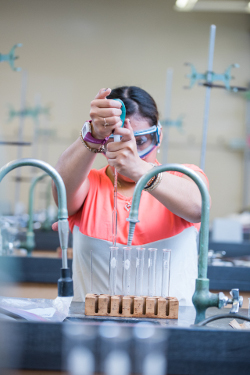
The department-wide effort to identify bottleneck courses and improve student success is connected to Graduation Initiative 2025, a system-wide effort by the CSU to increase retention and graduation rates, and eliminate achievement gaps.
The introductory chemistry course was notorious among students—a reputation reflected in a 50 to 60 percent passing rate for the course in 2011, depending on the section. That was the year that Chemistry Professor Chris Harmon was hired on the department, and, tasked with teaching Chem 109, he began to look into why nearly half of the students had to retake the course.
Harmon took a scientific approach to take a thorough look at coursework for Chemistry majors. “I’m an experimentalist myself. I relished the opportunity to look at these numbers,” he says. He began by looking at which students were passing and failing the course; what grade level were they in and what were their majors?
“Universally, regardless of major, freshmen were the poorest performing students,” he says. Addressing this, the department introduced a freshmen-only section of Chem 109 in 2014 taught by Professor Matt Hurst.
One of the first things they noticed was that Chem 109 tried to put a lot of material into one semester. Chemistry majors are required to take Chem 109 and 110, making up a year-long introduction course. But students from other majors—some Biology students, for example—got what they needed from Chem 109, due to the comprehensive (and intensive) workload and schedule.
So Harmon and others set out to redistribute the courseload more evenly between Chem 109 and Chem 110, convincing some departments that their students would be better served by taking both courses. This was successful in part, Harmon says, because low success rates meant that many students were spending two semesters in Chem 109 anyway.
Then Harmon looked at the class’s grading system. Previously, three to four large exams, a weekly quiz, and a final made up the entirety of a Chem 109 grade, making it difficult to recover from one poor test score. Since 2013, the department has made it a policy to introduce points for lab participation and a variety of online homework systems.
Harmon, and Professors Robert Zoellner and Matt Hurst also began to update lab manuals that hadn’t been edited since as far back as 1998. They’ve continued to edit them and provide them for free to students. The department has also introduced new technology, including iPad-like tablets (Vernier Lab Quest 2 TM) that connect to a variety of probes and tests used in the labs. The equipment allows students to process data in sophisticated ways – a far cry from the days of hand drawing graphs into notebooks.
For those who may be concerned that introductory courses may be getting too easy, Harmon points out that none of the coursework has been lost. “It is chemistry—it’s challenging,” he says. “We do want rigor.”
But redistributing coursework and opening the classes to more learning styles seems to be working. “Especially in general chemistry, there aren’t a lot of changes in the science, but there are a ton of changes in the pedagogy,” Harmon says.
That’s reflected in the numbers. Since the fall of 2013, the success rate of Chem 109 has risen from its prior 50 to 60 percent, and is now 70 to 80 percent.
“The number of successful freshmen has more than doubled while the number of successful sophomores, juniors, and seniors has decreased, likely because more students are passing earlier in their academic careers. Upper division students continue to have success rates in the 80-90 percent range,” Harmon says.
In addition to the significantly higher success rates, Harmon says the effect of the freshmen-only sections has been to help build a strong cohort of students early in their college careers—a technique that is widely considered to help overall graduation rates.
Harmon was more than happy to apply the scientific method to the problem of Chem 109—it was fitting for a science course, after all. But he stresses that the overhaul could be an example for others at HSU.